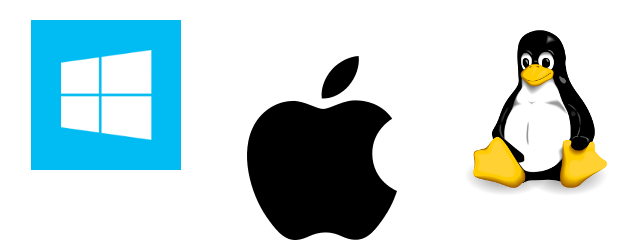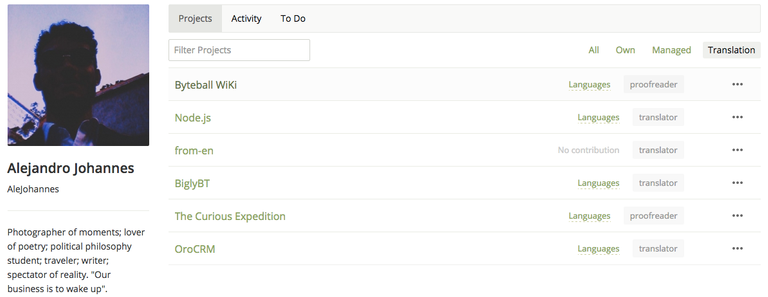Github Repository
https://github.com/nodejs/i18n
Project Details
By definition, Node.js is a Java Runtime Environment (JRE). But it is more than just that. While common JREs function as machine backups that allow users to smoothly run JavaScript on their browsers and applications, this open-source project functions as an app that manages Java code by itself. It's practical uses for developers are endless. It grants an extraordinarily versatile platform for designing code, programs, websites and other applications. And that isn't all: Node provides a virtual facility for testing the proper work of Java-driven programs and devices –and their planned updates–, helping to find bugs, solve errors, fix code and vastly improving their performance.
I believe all the amazing uses of Node are to be considered by themselves and I declare myself a fan of the project. But, besides, I support it for its functionality as a medium for bringing to reality countless creations that can be as good as Node itself. If you can dream it –and code it in JavaScript–, then your imagination is the only limit!The open translation of Node to thirty-three (33) languages proves the advantages of open-source projects when it comes to diversification of knowledge and worldwide spreading of useful tools.
Ahead, there is the link of the program's webpage:
Contribution Specifications
Translation Overview
This is my 42nd contribution to Node.js as a translator. For this collaboration, I continued my previous work on Node.js’ version 6 os.md file -explaining the use of operative system-specific features within the program-, finished it and starting translating the same version's url.md file, which describes the features and characteristics of url module of Node.
In my previous contribution, i talked about "constants" and defined them as:
Values that remain unaltered during the execution of a program. (...) each of them regulates different assets of said program, but the central concept is that they are quite the opposite of variables, as their values are not "writable" or adaptable in the middle of the execution. Together, they basically constitute the floor of the operations that are about to be performed.
In this document, I translated the specifications of a series of constants contained in the os module of Node.js. This module addressed signal constants, POSIX constants and Windows-specific constants. First, I'll refer ten signal constants and explain what they consist in:
- SIGHUP: it is used to point out when a controlling terminal is closed or a parent process exits.
- SIGINT: used to indicate when a user wishes to interrupt a process. Its hotkey is:
(Ctrl+C). - SIGQUIT: used to indicate when a user wishes to terminate a process and do a core dump.
- SIGILL: it is sent to a process to notify that there was an attempt to perform an illegal, malformed, unknown or privileged instruction.
- SIGTRAP: it is sent to a process when an exception has occurred.
- SIGABRT: it is sent to a process to request its abortion.
- SIGIOT: same as SIGABRT.
- SIGBUS: it is sent to a process to notify that it caused a bus error.
- SIGFPE: it is sent to a process to notify that it performed an illegal arithmetic operation.
- SIGKILL: it is sent to a process to terminate it immediately.
I'll now refer ten POSIX error constants:
- E2BIG: points out that the list of arguments is longer than expected.
- EACCES: indicates that the operation that was intended to be performed did not have sufficient permissions.
- EADDRINUSE: indicates that the network address is already being used.
- EADDRNOTAVAIL: indicates that the network address is currently unavailable.
- EAFNOSUPPORT: indicates that network address family that was input is not supported.
- EAGAIN: indicates that there is no data available for a specific operation and suggests to try it again later.
- EALREADY: indicates that the referred socket already has a pending connection in progress.
- EBADF: indicates that a file descriptor is not valid.
- EBADMSG: indicates that a data message is invalid.
- EBUSY indicates that a device or resource is currently busy.
And, finally, ten Windows-specific error constants:
- WSAEINTR: indicates an interrupted function call.
- WSAEBADF: indicates that a handle file is not valid.
- WSAEACCES: indicates that there are insufficient permissions to complete a planned operation.
- WSAEFAULT: indicates that a determined pointer address is invalid.
- WSAEINVAL: indicates that an invalid argument was passed.
- WSAEMFILE: indicates that there are too many open files at the moment.
- WSAEWOULDBLOCK: indicates that a resource is temporarily unavailable.
- WSAEINPROGRESS: indicates that an operation is currently in currently being performed.
- WSAEALREADY: indicates that a determined operation is already in progress.
- WSAENOTSOCK: indicates that a referred resource is not a socket.
We could go on and on explaining these... You get the point. There are constants for almost everything.

Continuing with the explanations of this contribution, I'll introduce my translations on the url.md file:
As explained in previous contributions, URL stands for Uniform Resource Locator and is the text references to web addresses. What this module does is resolving and parsing these. For this, the module counts with two APIs: a legacy API and an API that implements the WHATWG URL Standard used by web browsers.
But, what is an API?
API stands for "Application Programming Interface" and these are sets of procedures and instructions for the creation and execution of applications. These simplify the job of crafting and writing the whole code sequences for all the job that needs to be done when programing and reduce the required tasks to simple steps that fall within predefined sets of activities to be performed by the more useful interface for each.
And, last but not least, what is WHATWG?
WHATWG stands for Web Hypertext Application Technology Working Group and is an interconected web developers community that constantly work to make HTML and online conectivity better. It was created in 2004 and is still active! You can check out their webpage for more information.

You can find out more about the aforementioned concepts here:
- https://www.webopedia.com/TERM/C/constant.html
- https://www.geeksforgeeks.org/constants-in-c/
- https://www.tutorialspoint.com/cprogramming/c_constants.htm
- https://www.webopedia.com/TERM/U/URL.html
- https://www.webopedia.com/TERM/A/API.html
- https://www.howtogeek.com/343877/what-is-an-api/
- https://www.infoworld.com/article/3269878/what-is-an-api-application-programming-interfaces-explained.html
- https://www.mulesoft.com/resources/api/what-is-an-api
- https://whatwg.org/
- https://es.wikipedia.org/wiki/Web_Hypertext_Application_Technology_Working_Group

Thanks for taking your time to read! Expect more information and tips on the next report :)

Work example #01:
English:
Note that while ENOTSUP and EOPNOTSUPP have the same value on Linux, according to POSIX.1 these error values should be distinct.)
Spanish:
Nótese que aunque ENOTSUP y EOPNOTSUPP tienen el mismo valor en Linux, estos valores deben ser distintos de acuerdo a POSIX.1.
Work example #02:
English:
Indicates that successful WSAStartup has not yet been performed.
Spanish:
Indica que aún no se ha efectuado con éxito el WSAStartup.
Work example #03:
English:
<0>Nota</0>: De acuerdo con las convenciones de los navegadores, todas las propiedades de los objetos <1>URL</1> son implementadas como getters y setters en el prototipo de la clase, y no como propiedades de datos en el objeto en sí.
Spanish:
<0>Nota</0>: De acuerdo con las convenciones de los navegadores, todas las propiedades de los objetos <1>URL</1> son implementadas como getters y setters en el prototipo de la clase, y no como propiedades de datos en el objeto en sí.
Languages
This translation was made from English to Spanish.
I got plenty experience translating and proofreading this project as an Utopian contributor. I collaborate here as translator and Language Moderator of the Da-Vinci/Utopian Spanish translation team. Besides this project, I have experience translating and proofreading The Curious Expedition, Ancap-ch, Byteball Wiki, OroCrm and BiglyBT.
Word Count
- The amount of words translated in this contribution is: 1,315.
Note: This number is the result of subtracting the complete sum of non-translatable content to the word-count Crowdin has done for the period in which this contribution was done.
- The total amount of words translated in this project (as a Da-vinci/Utopian translator) is: 52,233.
Previous Translations of the Project
- Contribution N'01. Submitted on September 13th, 2018.
- Contribution N'02. Submitted on September 15th, 2018.
- Contribution N'03. Submitted on September 17th, 2018.
- Contribution N'04. Submitted on September 19th, 2018.
- Contribution N'05. Submitted on September 21th, 2018.
- Contribution N'06. Submitted on September 22th, 2018.
- Contribution N'07. Submitted on September 23th, 2018.
- Contribution N'08. Submitted on October 1st, 2018.
- Contribution N'09. Submitted on October 8th, 2018.
- Contribution N'10. Submitted on October 14th, 2018.
- Contribution N'11. Submitted on October 15th, 2018.
- Contribution N'12. Submitted on October 18th, 2018.
- Contribution N'13. Submitted on October 21st, 2018.
- Contribution N'14. Submitted on October 24th, 2018.
- Contribution N'15. Submitted on October 27th, 2018.
- Contribution N'16. Submitted on October 31th, 2018.
- Contribution N'17. Submitted on November 3rd, 2018.
- Contribution N'18. Submitted on November 4th, 2018.
- Contribution N'19. Submitted on November 6th, 2018.
- Contribution N'20. Submitted on November 17th, 2018.
- Contribution N'21. Submitted on November 24th, 2018.
- Contribution N'22. Submitted on December 7th, 2018.
- Contribution N'23. Submitted on December 15th, 2018.
- Contribution N'24. Submitted on December 20th, 2018.
- Contribution N'25. Submitted on December 26th, 2018.
- Contribution N'26. Submitted on December 28th, 2018.
- Contribution N'27. Submitted on December 30th, 2018.
- Contribution N'28. Submitted on January 9th, 2019.
- Contribution N'29. Submitted on January 10th, 2019.
- Contribution N'30. Submitted on January 12th, 2019.
- Contribution N'31. Submitted on January 18th, 2019.
- Contribution N'32. Submitted on January 19th, 2019.
- Contribution N'33. Submitted on January 24th, 2019.
- Contribution N'34. Submitted on January 28th, 2019.
- Contribution N’35. Submitted on January 31st, 2019.
- Contribution N’36. Submitted on March 3rd, 2019.
- Contribution N’37. Submitted on March 6th, 2019.
- Contribution N’38. Submitted on April 3rd, 2019.
- Contribution N’39. Submitted on April 16th, 2019.
- Contribution N’40. Submitted on April 19th, 2019.
- Contribution N’41. Submitted on May 28th, 2019.
Proof of Authorship
This translation was made from May 28th to June 2nd, 2019. You can check the translation record in my Crowdin account [here], the activity on the project's Crowdin [here] and a summary of recent additions to the project [here].
 z
z

Hi @alejohannes,
Thank you for submitting your contribution!
This is a very interesting project that contains many code values and terms related to computer science. Its difficulty relies on the fact that we must pay a lot of attention to the code in order to deliver the most accurate translation possible.
The overall presentation of your post is great, it is well written and formatted, includes all the basic details, useful examples and concepts.
You delivered an accurate translation. You used the correct vocabulary and you were careful with code values that should not be translated in order to make sure the text keeps its true meaning.
Keep up the good work :)
Your contribution has been evaluated according to Utopian policies and guidelines, as well as a predefined set of questions pertaining to the category.
To view those questions and the relevant answers related to your post, click here.
Chat with us on Discord
Thank you for your review, @marugy99! Keep up the good work!
Hi @alejohannes!
Feel free to join our @steem-ua Discord serverYour post was upvoted by @steem-ua, new Steem dApp, using UserAuthority for algorithmic post curation! Your post is eligible for our upvote, thanks to our collaboration with @utopian-io!
Hey, @alejohannes!
Thanks for contributing on Utopian.
We’re already looking forward to your next contribution!
Get higher incentives and support Utopian.io!
SteemPlus or Steeditor). Simply set @utopian.pay as a 5% (or higher) payout beneficiary on your contribution post (via
Want to chat? Join us on Discord https://discord.gg/h52nFrV.
Vote for Utopian Witness!